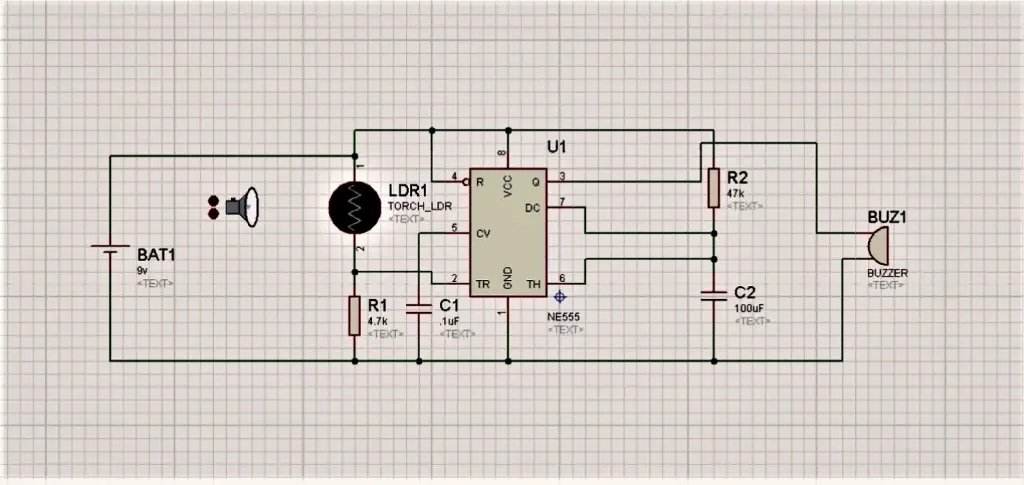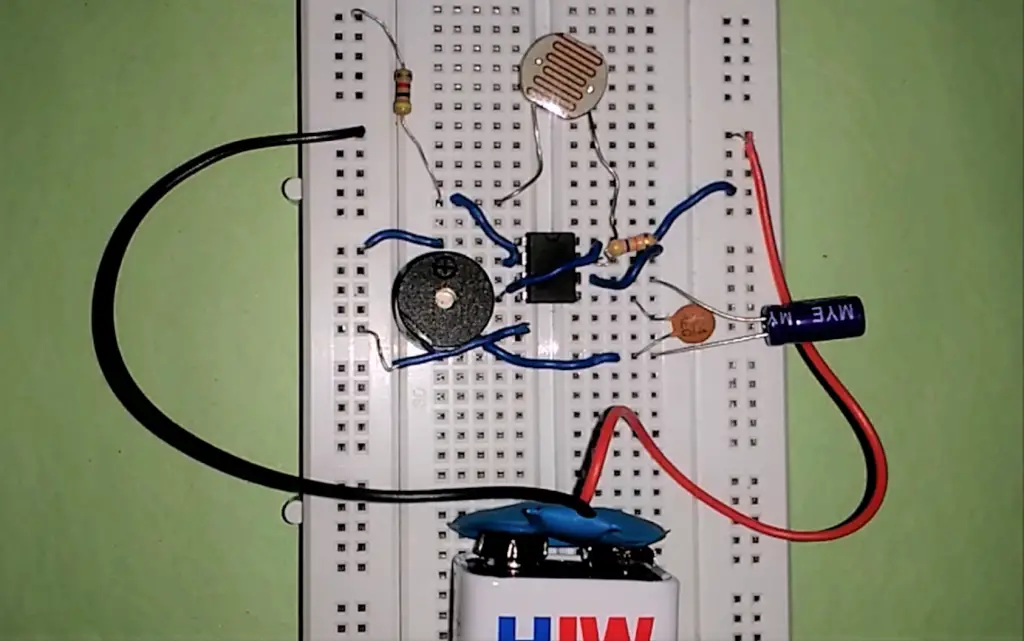Last updated on March 1st, 2024 at 12:39 pm
This LDR and 555 timer-based DARK SENSOR indicates the absence of light or the presence of dark in a certain region.
Whenever the intensity of light falling on this circuit(sensor) is below a certain value, a buzzer connected to the output of the IC 555 timer will produce sound and thereby act as a DARK SENSOR.
Components required
- 555 timer
- one ldr
- one buzzer
- capacitors 100uf and .01uf
- 9volt battery
- resistors 4.7k and 47k
555 timer is one of the most common and popular ICs among electronic hobbyists and engineers, even after more than 46 years of its invention.
Due to its wide range of applications in electronics, many projects can be easily made using this IC. 555 timer is used for many purposes in the electronic industry as a monostable and astable multivibrator. 555 timer can also be used as a DARK SENSOR in its monostable mode or single shot mode.
Now, apart from the 555 timer we also need one LDR(light-dependent resistor) to build this 555 TIMER project. The work of LDR is to sense the light in the surroundings and then send the details to the 555 timer.
LDR or light-dependent resistor is a special kind of variable resistor that changes its resistance according to the intensity of light falling on it. As the intensity of light increases, its resistance decreases. We need this property of LDR for our DARK SENSOR.
Circuit diagram:

| Pin no. | 555 Pins | Connections |
|---|---|---|
| 1 | GND | To -ve terminal of a battery |
| 2 | TRIGGER | Between LDR and 4.7k resistor |
| 3 | OUTPUT | To Buzzer |
| 4 | RESET | To +ve terminal of battery |
| 5 | CONTROL | To .1uf capacitor |
| 6 | THRESHOLD | Between 47 k resistor & 100 uf capacitor |
| 7 | DISCHARGE | Between 47 k resistor & 100 uf capacitor |
| 8 | VCC | To +ve terminal of battery |
Working:
Watch this video to see ‘DARK SENSOR’ in action!
Two important points to consider in a 555 timer:
A. Output or Pin 3 of 555 timers will be 1(HIGH) only when the voltage at pin 2 or trigger pin is less than 1/3v of the applied voltage at Vcc pin of 555.
Since the battery is 9 volts, hence :
1/3 of 9 = 3 volts
B. Capacitor (100 uf) discharges through discharge pin (7th) to ground as soon as the voltage at 6 pins or threshold pin of 555 timers is greater than 2/3v of the applied voltage at 8 pins or Vcc pin.
2/3 of 9 = 6 volts
Case 1: when the light falls on the LDR.
In this case, the resistance of LDR is minimum so all voltage drop is across 4.7k resistor, due to which voltage at pin 2 or trigger pin is greater than 1/3 of 9v causing a reset of flip-flop inside the 555 timer and thus zero voltage at the output(pin 3). Now since the output pin is directly connected to a buzzer, it produces no sound.
Case 2: When no light falls on LDR
In this case, the resistance of LDR is maximum, so all voltage drop is across LDR, due to which voltage at pin 2 or trigger pin is less than 1/3 of 9v, causing a set of flip-flops inside the 555 timer and thus one as output(pin 3). Now since the output pin is directly connected to the buzzer, it produces a beep sound.

